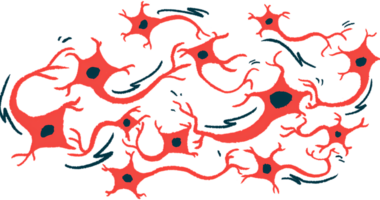Identifying Role of Proteins in Nerve Cells of Living Brain Possible

A new technique allowed researchers to label with specificity proteins inside neurons of the striatum — a brain region involved in voluntary movement control — within a living mouse.
These findings may help scientists better understand the millions of distinct proteins in the brain and their interactions within neurons (nerve cells), and how their role changes under neurodegenerative diseases like Parkinson’s.
The study “Cell-type and subcellular compartment-specific APEX2 proximity labeling reveals activity-dependent nuclear proteome dynamics in the striatum” was published in the journal Nature Communications.
While recent research has identified the role and dynamics of genes and messenger RNA — the molecule generated from DNA that serves as a template for protein production — in neurodegenerative disorders, the dynamics of proteins themselves are far from clear.
Advanced techniques exist to amplify and sequence genes, but not for proteins, which is much harder.
For example, profiling a protein’s building blocks — called amino acids — is currently a slow and imperfect process, requiring that proteins are broken down to smaller fractions (peptides), which are then put back together.
“We have been able to gain a lot of traction with genetic and RNA sequencing, but proteins have been out of the loop,” Yevgenia Kozorovitskiy, a neurobiology professor at Northwestern’s Weinberg College of Arts and Sciences and the study’s lead author, said in a university press release.
“Yet everyone recognizes the importance of proteins. Proteins are the ultimate effectors in our cells. Understanding where proteins are, how they work and how they work relative to each other is really important,” she added.
Particularly challenging is understanding the role of proteins in the living brain and within different nerve cells, and how these cell-type-specific proteomes, or the entire protein content within a cell, determine their function.
Researchers at Northwestern University and the University of Pittsburgh developed a technique, called proximity labeling, that allows them to chemically tag proteins in a manner specific to cell types and, importantly, within the brain of a living animal.
Using a viral vector, they were able to deliver an enzyme called APEX2 to the striatum of a mouse. The virus also carried a separate green fluorescent protein for visualizing.
The enzyme, derived from soybeans, was engineered to target different compartments — the nucleus, cell body and membrane — within nerve cells of the striatum. Once there, the enzyme tagged its neighboring proteins.
“The virus essentially acts as a message that we deliver,” Kozorovitskiy said. “In this case, the message carried this special soybean enzyme. Then, in a separate message, we sent the green fluorescent protein to show us which neurons were tagged. If the neurons are green, then we know the soybean enzyme was expressed in those neurons.”
While this approach had been used in lab tests with cells grown in a dish, this work is believed to be the first time proteins were tagged in a living animal’s brain — important because “cells in a dish do not work the same way they do in a brain, and they don’t have the same proteins in the same places doing the same things,” Kozorovitskiy said.
“It’s a lot more challenging to do this work in the complex tissue of a mouse brain,” she added.
Researchers then mapped the entire proteome of the different neurons in the striatum and their subcellular contents using mass spectroscopy-based proteomics, a technique that can help profile proteins, as well as their interactions and modifications.
“Mapping the proteome with both cell-type and compartment specificity is crucial for understanding coordinated functions of cells and neural circuits in the vertebrate brain,” the scientists wrote.
Combining proximity labeling to tag cell-type and subcellular proteins, together with proteomics, allowed researchers to take a snapshot of the entire set of proteins inside living neurons. Moreover, it showed how nerve cells change their protein profile in response to different stimuli.
“With our approach, we can start mapping the proteome of various brain circuits with high precision and specificity. We can even quantify them to see how many proteins are present in different parts of neurons and the brain,” said Vasin Dumrongprechachan, a PhD candidate and the study’s first author.
The team plans to use their approach with mouse models of neurodegenerative diseases, including Parkinson’s, to further understand how protein location and function changes during a disorder’s course.
Since the technique can also be used with postmortem brain tissue, it offers an opportunity to advance study into disease features in people.
“We look forward to taking this to models related to brain diseases and connect those studies to postmortem proteomics work in the human brain,” Kozorovitskiy said. “It’s ready to be applied to those models.”







